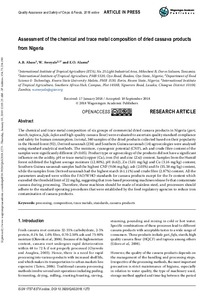| dc.contributor.author | Abass, A. |
| dc.contributor.author | Awoyale, W. |
| dc.contributor.author | Alamu, E.O. |
| dc.date.accessioned | 2019-12-04T11:30:11Z |
| dc.date.available | 2019-12-04T11:30:11Z |
| dc.date.issued | 2018-12-21 |
| dc.identifier.citation | Abass, A., Awoyale, W. & Alamu, E. O. (2018). Assessment of the chemical and trace metal composition of dried cassava products from Nigeria. Quality Assurance and Safety of Crops & Foods, 1-10. |
| dc.identifier.issn | 1757-8361 |
| dc.identifier.uri | https://hdl.handle.net/20.500.12478/5217 |
| dc.description | Open Access Journal |
| dc.description.abstract | The chemical and trace metal composition of six groups of commercial dried cassava products in Nigeria (gari, starch, tapioca, fufu, lafun and high-quality cassava flour) were evaluated to ascertain quality standard compliance and safety for human consumption. In total, 340 samples of the dried products collected based on their popularity in the Humid forest (92), Derived savannah (234) and Southern Guinea savannah (14) agroecologies were analysed using standard analytical methods. The moisture, cyanogenic potential (CNP), ash and crude fibre content of the samples were significantly different (P<0.05). Product type or agroecology of the products did not have a significant influence on the acidity, pH or trace metal (copper (Cu), iron (Fe) and zinc (Zn)) content. Samples from the Humid forest exhibited the highest average moisture (12.80%), pH (6.62), Zn (5.01 mg/kg) and Cu (3.16 mg/kg) content; Southern Guinea savannah samples had the highest CNP (9.06 mg/kg), ash (2.03%) and Fe (35.38 mg/kg) content, while the samples from Derived savannah had the highest starch (61.11%) and crude fibre (2.87%) content. All the parameters analysed were within the FAO/WHO standards for cassava products except for the Fe content which exceeded the threshold limit of 22 mg/kg, suggesting that iron-based processing machines release Fe that contaminate cassava during processing. Therefore, these machines should be made of stainless steel, and processors should adhere to the standard operating procedures that were established by the food regulatory agencies to reduce iron contamination of cassava products. |
| dc.description.sponsorship | International Fund for Agricultural Development |
| dc.format.extent | 1-10 |
| dc.language.iso | en |
| dc.rights | CC-BY-NC-SA-4.0 |
| dc.subject | Processing |
| dc.subject | Composition |
| dc.subject | Trace |
| dc.subject | Metals |
| dc.subject | Standards |
| dc.subject | Cassava |
| dc.subject | Products |
| dc.title | Assessment of the chemical and trace metal composition of dried cassava products from Nigeria |
| dc.type | Journal Article |
| dc.description.version | Peer Review |
| cg.contributor.crp | Agriculture for Nutrition and Health |
| cg.contributor.crp | Roots, Tubers and Bananas |
| cg.contributor.affiliation | International Institute of Tropical Agriculture |
| cg.coverage.region | Africa |
| cg.coverage.region | West Africa |
| cg.coverage.country | Nigeria |
| cg.creator.identifier | Adebayo Abass: 0000-0003-1376-3608 |
| cg.creator.identifier | Wasiu Awoyale: 0000-0002-3635-1414 |
| cg.creator.identifier | Alamu Emmanuel Oladeji: 0000-0001-6263-1359 |
| cg.researchtheme | SOCIAL SCIENCE & AGRIBUSINESS |
| cg.researchtheme | NUTRITION & HUMAN HEALTH |
| cg.isijournal | ISI Journal |
| cg.authorship.types | CGIAR single centre |
| cg.iitasubject | Agribusiness |
| cg.iitasubject | Nutrition |
| cg.journal | Quality Assurance and Safety of Crops & Foods |
| cg.howpublished | Formally Published |
| cg.accessibilitystatus | Open Access |
| local.dspaceid | 102945 |
| cg.targetaudience | Scientists |
| cg.identifier.doi | https://dx.doi.org/10.3920/QAS2018.1273 |

